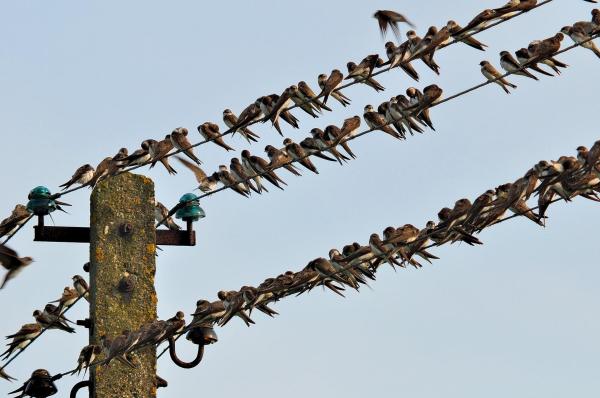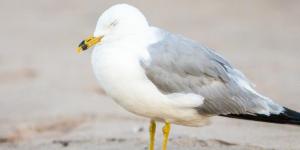Where Do Swallow Birds Sleep?


Swallows are several species of birds that belong to the Hirundinidae family and have a wide distribution. Some are migratory birds, others are not. Those that are migratory can travel thousands of miles south to below the equator to find warmth and food during cold months. When winter is over, they migrate back north to nest. Now that spring has arrived, it is increasingly common to see swallows basking in the sun in both rural and urban areas. Yet, have you ever wondered where swallows spend the night?
In this AnimalWised article, we discuss where and how swallows sleep, as well as a few other interesting facts about their roosting and nesting habits.
When do swallows sleep?
Swallows are diurnal birds, meaning they are active during the day and sleep at night. However, when they migrate, their sleeping habits change dramatically.
During their spring and fall migration, swallows fly at night because it is safer. During their nocturnal migrations, they forgo much of their sleep, but are able to make up at least some lost sleep on land during the day by taking occasional naps.
Check out this other article on why animals migrate to learn more about migratory animals.
Where do swallows nest and sleep?
Swallows have adapted to urban and suburban areas, so it is not uncommon to see them in buildings, bridges, barns, etc. In the wild, they prefer steep slopes, ravines, and caves. As a rule, swallows prefer to live near water.
Most people assume that swallows, like most birds, sleep in nests. This is true to a certain extent. It is important to clarify what nests are really for: babies. Nests are built primarily because the eggs need protection from the weather (heat and cold, wind and rain) and from other animals that would eat them. When an adult bird perches on eggs and nestlings, it can sleep in the nest, especially at night. As soon as the young swallows are big enough to live on their own, the whole family will leave the nest. This brings us to another question: where do they sleep the rest of the year?
When swallows sleep outside the nest, they sleep in places called roosts.
During the migratory months, swallows roost at night in large flocks at traditional roost sites. During the rest of the year, when they are not nesting nor migrating, swallows roost in tree branches, on rock ledges, or in tree cavities. Swallows live in a variety of habitats worldwide, so the places where they nest and sleep can vary depending on the environment. Here are some examples of roosts and nests of some of the most common swallow species:
- Sand martin (Riparia riparia): prefers sandy shores, riverbanks or coastal areas, gravel pits, quarries, or areas near roads. They also look for places to dig burrows to hide, roost or build their nests, which they construct from grasses, feathers and various materials they find in their environment.
- Cliff swallow or American cliff swallow (Petrochelidon pyrrhonota): as its name suggests, it prefers to seek out these open areas in mountainous regions, ravines, hills, or even valleys. Due to the development of cities and roads, they have adapted well to these spaces and use them as places of refuge and rest. Wherever it stays, it builds dome-shaped nests made of clay that have a small opening to enter or exit. This species is quite gregarious, forming groups of hundreds of pairs that build their nests very close to each other.
- Blue Swallow (Hirundo atrocaerulea), native to the African continent, can use natural places such as caves or anteater dens, but also man-made places such as abandoned mines. In each of these places, it seeks refuge and rests, but it also builds cup-shaped nests of mud and twigs during the breeding season.
- White-tailed Swallow (Hirundo megaensis), which is endemic to Ethiopia, lives mainly in scrub and rural areas. Nesting, roosting, and resting sites include human-built huts on roofs or beams, where they feel secure and protected from the weather. A less common place where they build their nests is termite mounds. It is not easy to determine how often they perform this last action, as it is not possible to observe exactly whether they have nested in this type of structure, but they have been known to do so.
- Tree Swallow (Tachycineta bicolor), native to the continental United States, develops in places such as reedbeds, marshes, fields, beaver ponds, and wooded areas with water. When not breeding, it roosts at night either in reeds or out of the water, but it may also live in trees or man-made structures. During the breeding season, it builds its nests in trees, in sheltered places on the ground, or in buildings, where it spends most of its time.
Swallows are a diverse group, but the above examples give us a general idea of the types of spaces these birds may use for roosting. We recommend you read this other article to learn more about the different types of swallows.
How do swallows sleep?
So far, we have seen that there are so many species of swallows with different sleeping habits depending on things like the environment and whether or not they migrate.
Migrating swallows and other birds such as crows, swifts, and starlings tend to do communal roosting. This means that they tend to gather in large flocks when they sleep.
Swallows congregate at the same time every day because they rely on external repetitive environmental cues such as nightfall or high tide. The birds always return to the same location when the signal reappears when they are not migrating.
Roosting communally is beneficial for many reasons, including:
- Better foraging
- Lower thermoregulation requirements
- Fewer predators
- More interaction with conspecifics
Other swallow species, however, especially those that do not migrate, do not congregate in large flocks. They usually nest in pairs, alone (when not nesting), or in small groups of no more than ten members.
If you want to learn more about swallows and other migratory birds, check out this other article on Swallows, swifts, and Martins.

If you want to read similar articles to Where Do Swallow Birds Sleep?, we recommend you visit our Facts about the animal kingdom category.
- Myers, P., R. Espinosa, CS Parr, T. Jones, GS Hammond, and TA Dewey. (2022). Animal Diversity website. Available at: https://animaldiversity.org/
- IUCN (2022). IUCN Red List of Threatened Species. Version 2021-3. Available at: https://www.iucnredlist.org






